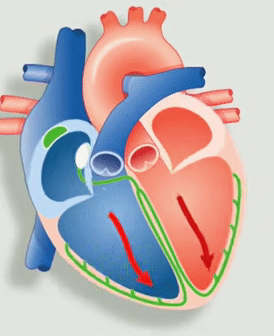S1E9: How do Pacemakers work?
Introduction
Your pacemaker stimulates your heart with electrical impulses to restore a normal rhythm, so you can live a more active life.
About 3 million people worldwide are living with a pacemaker, and my grandfather had one too! Let’s see how they work.
How does your heart work? 101
Figure 1: Heart chambers anatomy. Source: Economist
The deoxygenated blood from the body flows into the right atrium and oxygenated blood from the lungs flows into the left atrium. An electrical signal from the sinoatrial node (the green node not connected to any fibers in Figure 2.) causes the atrium to contract. Thus, opening the one-way valve for the blood to flow to the right and left ventricle chambers respectively.
Now, the electrical signal from the atrioventricular node (the green node connected to fibers in Figure 2) causes the ventricles to contract, thereby pushing the blood from the right ventricle to the lungs and from the left ventricle to the body.
Figure 2: Animation of heart’s electrical system
Why do we need Pacemakers?
Electricity drives our heartbeats. A bundle of nerves at the heart (the green nodes in Figure 2) is an electrical generator. Nerves, functioning as wires, transmit messages to the lower chambers of your heart, signaling when to contract. A slow heart rate can prevent the heart from pumping enough oxygen-rich blood, and can even cause serious conditions such as heart failure or even death. Hence, we use a computerized device called Pacemaker that makes sure that the heart beats at the required beats per minute.
How do Pacemakers work?
Traditional pacemakers have three main parts.
A pulse generator creates electrical pulses. It is a small metal case that contains electronic circuitry with a small computer and a battery that regulate the impulses sent to the heart.
Wires are implanted inside the veins and carry the pulses to your heart. It is connected to the pulse generator on one end, with the other end placed inside one of the heart's chambers.
Electrodes deliver electrical impulses to your heart to make it beat normally. The electrode on the end of a lead touches the heart wall. The lead delivers electrical impulses to the heart. These signals cause stimulation of the heart muscle making them contract.
A traditional pacemaker generator is placed outside of your heart, either in your chest or abdomen. And the pacemaker sends electrical signals only when the natural heartbeat is not optimal.
Conclusion
The data is stored in the pacemaker which the doctor can review for post-processing and can also adjust the settings if needed. There have been further developments like using wireless pacemakers and many other different models. But the big picture has been the same, generating electrical signals :)
Thank you for taking the time to read my blog post. If you liked what you read, consider subscribing to my newsletter for exclusive content and understand how a gadget works in only 3 minutes, sent directly to your inbox every Wednesday. We'd love to have you as a part of our community. Also, if you found this post to be informative or enjoyable, please share this with your friends on social media. Thank you!



